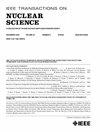Gamma Radiation-Induced Darkening Effect on Ytterbium-Doped Fiber Oscillators
IF 1.9
3区 工程技术
Q3 ENGINEERING, ELECTRICAL & ELECTRONIC
引用次数: 0
Abstract
Under gamma irradiation, the output power of the fiber laser gradually decreases due to the rise of radiation-induced attenuation (RIA) also known as the radiation-induced darkening effect. This phenomenon may lead to a decreased threshold of transverse mode instability, reducing the stability and beam quality of the fiber lasers. Understanding the darkening effect on fiber lasers, particularly high-power oscillators, is necessary. This work comprehensively investigates the irradiation effect on the ytterbium-doped fiber (YDF) oscillator operating at around 200 W online and the annealing process afterward. During the irradiation process, we find that the RIA of the rare-earth-doped fiber increased linearly with the total radiation dose, due to the generation of color centers. The output power of the 1060-nm oscillator decreased by nearly 12% after 6 krad(Si) irradiation, which recovered to 90.6% after annealing for 15 min. For the 1080-nm oscillator, its power dropped by almost 13% under 3 krad(Si) irradiation, recovering to 91.2% after 30-min annealing. We further constructed a rate equation model and calculated the radiation sensitivity of the fiber irradiation position and fiber pumping scheme. We find that the radiation-resistant performance of the backward pumping is better than that of the forward pumping. Our result is valuable to understand the radiation-induced darkening effect and for the development of radiation-resistant fiber lasers.辐射诱发掺镱光纤振荡器的变暗效应
在伽马辐照下,光纤激光器的输出功率由于辐射诱导衰减(RIA)的增加而逐渐降低,也称为辐射诱导变暗效应。这种现象可能导致横向模不稳定阈值降低,降低光纤激光器的稳定性和光束质量。了解光纤激光器,特别是高功率振荡器的变暗效应是必要的。本文全面研究了在线工作在200w左右的掺镱光纤(YDF)振荡器的辐照效应及其退火过程。在辐照过程中,我们发现由于色心的产生,掺稀土光纤的RIA随总辐射剂量线性增加。1060 nm振荡器的输出功率在6 krad(Si)照射后下降了近12%,退火15 min后恢复到90.6%。1080 nm振荡器的输出功率在3 krad(Si)照射下下降了近13%,退火30 min后恢复到91.2%。我们进一步建立了速率方程模型,计算了光纤辐照位置和光纤泵浦方案的辐射灵敏度。我们发现反向抽运的抗辐射性能优于正向抽运。我们的研究结果对于理解辐射致暗效应和开发抗辐射光纤激光器具有重要的参考价值。
本文章由计算机程序翻译,如有差异,请以英文原文为准。
求助全文
约1分钟内获得全文
求助全文
来源期刊

IEEE Transactions on Nuclear Science
工程技术-工程:电子与电气
CiteScore
3.70
自引率
27.80%
发文量
314
审稿时长
6.2 months
期刊介绍:
The IEEE Transactions on Nuclear Science is a publication of the IEEE Nuclear and Plasma Sciences Society. It is viewed as the primary source of technical information in many of the areas it covers. As judged by JCR impact factor, TNS consistently ranks in the top five journals in the category of Nuclear Science & Technology. It has one of the higher immediacy indices, indicating that the information it publishes is viewed as timely, and has a relatively long citation half-life, indicating that the published information also is viewed as valuable for a number of years.
The IEEE Transactions on Nuclear Science is published bimonthly. Its scope includes all aspects of the theory and application of nuclear science and engineering. It focuses on instrumentation for the detection and measurement of ionizing radiation; particle accelerators and their controls; nuclear medicine and its application; effects of radiation on materials, components, and systems; reactor instrumentation and controls; and measurement of radiation in space.
 求助内容:
求助内容: 应助结果提醒方式:
应助结果提醒方式:


